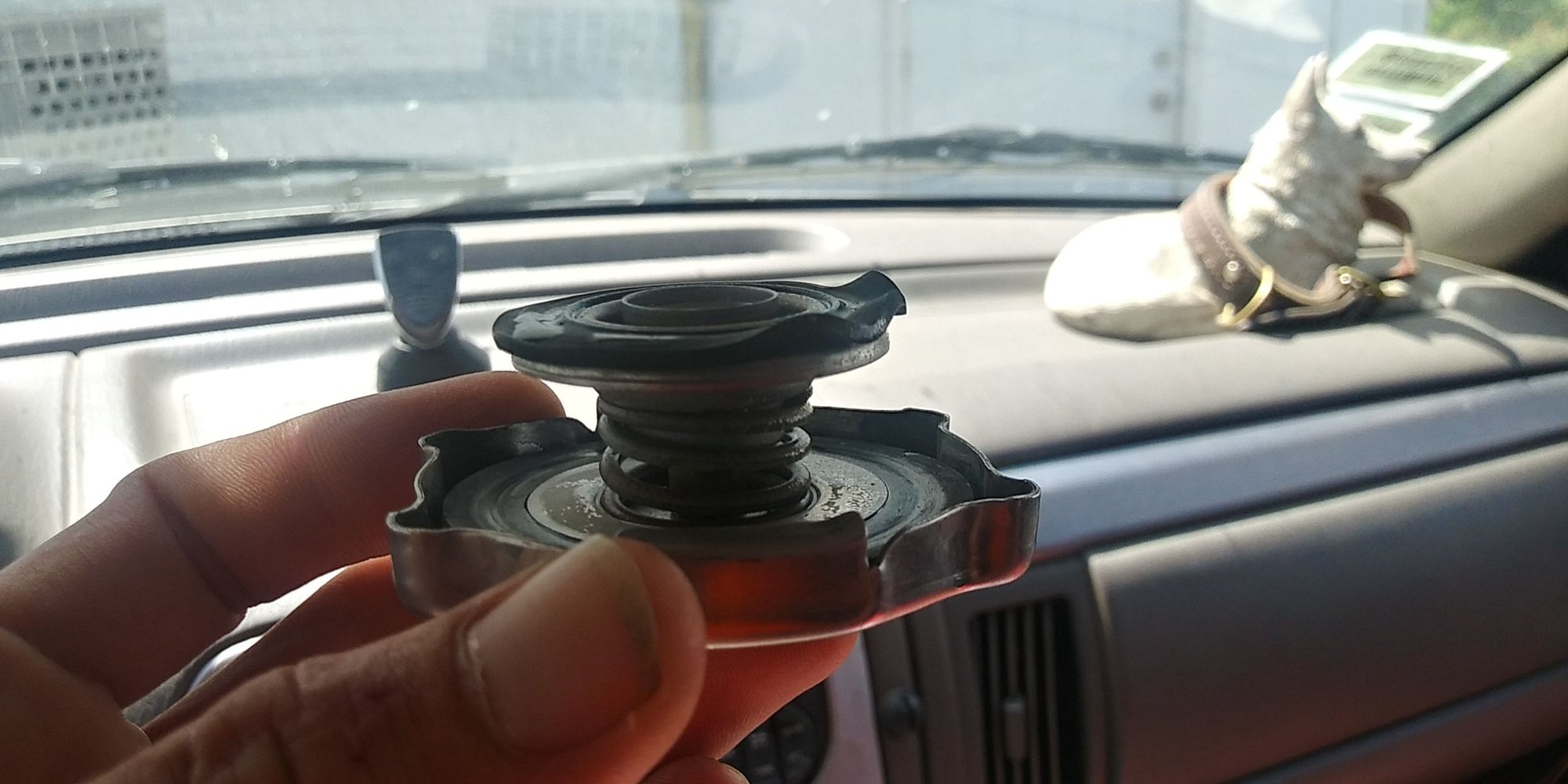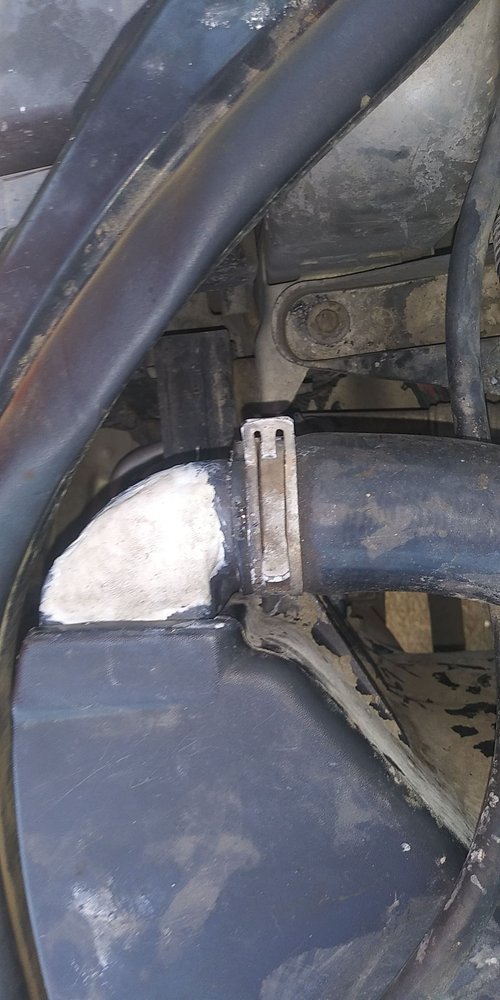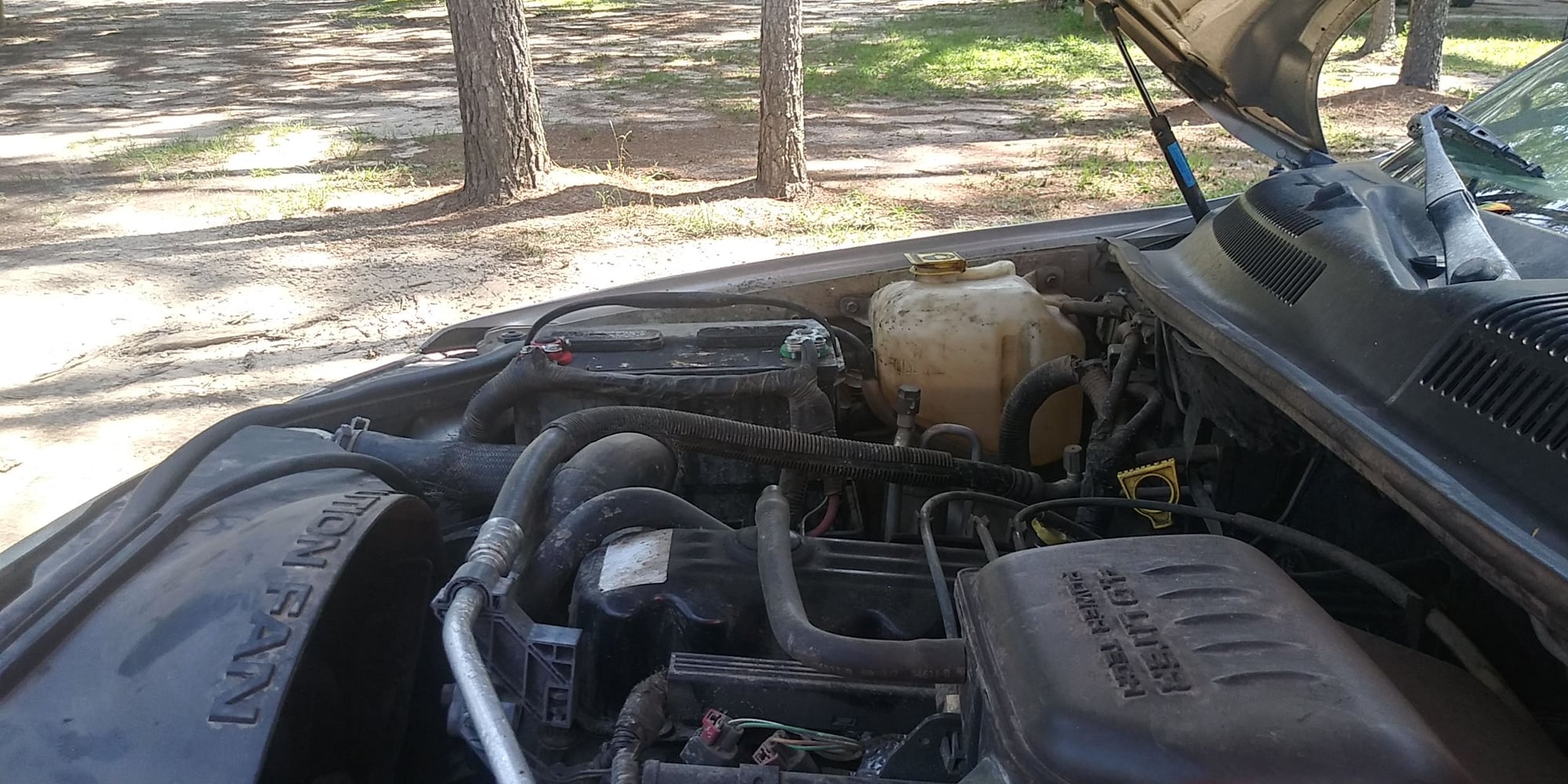I got a problem - It's my radiator
#16
Banned
Thread Starter
I know guys...
I peeled up all of the old epoxy. It has not changed any from what it looked like three years ago. What I mean by this is that you cannot see anything wrong, or out of the ordinary with it by looking at it. It looks normal. There is no line, crack, or hole. There is nothing. The spot does not look in any way damaged or broken at all. It looks physically complete and intact, like you would expect to see. Nothing obvious at all. The only indication that something appears off there is from the light sanding marks I have put down with 150grit. The only way to really see the problem is by running the Jeep until its hot with the thermostat open, and then squeezing the upper radiator hose. That makes the coolant seep out from what seems to be completely intact plastic, from some invisible pinhole. After turning the Jeep off is when it sometimes streams out, and drips down steady until it cools off some. It is not obvious though. You have to be looking closely because it is such a relatively small amount leaking. With the old epoxy giving out today and yesterday, I could hear a steady hiss anytime it was hot with an open thermostat.. I think because of the confined space created by the epoxy covering up whatever defect is there. I honestly believe it is some kind of factory defect that has been there since day one when it was brand new?
It is fixed now. I peeled up the old stuff, sanded, and cleaned the area. Then, redid the plasti-weld again with epoxy. It says it should be cured at this point, but I won't be starting it up to see until tomorrow. The first round of plasti-weld held for 57,000 miles. I guess I will see tomorrow if this round of plasti-weld makes it a mile? It appears to look extremely well sealed up again to me right now though. I am very sure that this fix is going to remedy the issue for a good long amount of time. I hope I am right? I will be giving it a 540 mile test-run, the day after tomorrow when I take it to Louisiana. Provided that I am satisfied with how it works out when I drive it around some tomorrow.
I peeled up all of the old epoxy. It has not changed any from what it looked like three years ago. What I mean by this is that you cannot see anything wrong, or out of the ordinary with it by looking at it. It looks normal. There is no line, crack, or hole. There is nothing. The spot does not look in any way damaged or broken at all. It looks physically complete and intact, like you would expect to see. Nothing obvious at all. The only indication that something appears off there is from the light sanding marks I have put down with 150grit. The only way to really see the problem is by running the Jeep until its hot with the thermostat open, and then squeezing the upper radiator hose. That makes the coolant seep out from what seems to be completely intact plastic, from some invisible pinhole. After turning the Jeep off is when it sometimes streams out, and drips down steady until it cools off some. It is not obvious though. You have to be looking closely because it is such a relatively small amount leaking. With the old epoxy giving out today and yesterday, I could hear a steady hiss anytime it was hot with an open thermostat.. I think because of the confined space created by the epoxy covering up whatever defect is there. I honestly believe it is some kind of factory defect that has been there since day one when it was brand new?
It is fixed now. I peeled up the old stuff, sanded, and cleaned the area. Then, redid the plasti-weld again with epoxy. It says it should be cured at this point, but I won't be starting it up to see until tomorrow. The first round of plasti-weld held for 57,000 miles. I guess I will see tomorrow if this round of plasti-weld makes it a mile? It appears to look extremely well sealed up again to me right now though. I am very sure that this fix is going to remedy the issue for a good long amount of time. I hope I am right? I will be giving it a 540 mile test-run, the day after tomorrow when I take it to Louisiana. Provided that I am satisfied with how it works out when I drive it around some tomorrow.
Last edited by Noah911; 07-17-2019 at 11:10 PM.
#18
Old fart with a wrench
Having worked for over 50 years in the plastic injection molding business, I can honestly say it not beyond the realm of possibility that it was defective when it came out of the mold or was stress cracked by the press operator trying to remove a stuck part. Molding that hose neck requires a complicated mold with multiple side cores that have to match perfectly to keep plastic from flowing between the parts. They have experimented with blow molding parts like that such as you would a plastic bottle, but the problem is inconsistent wall thicknesses. The molding machine pumps out hundreds of parts every day and they can't all be checked for quality. Not only that, but they may be molded by different manufacturers and for different buyers. My last job before I retired was working for a small custom molder in a rural town and we ran molds for Remington, Lego, GM, Martin-Merrietta, and a few small ones for the military. We even ran a plaster shield for Moen that was used to mount shower controls so they would be flush when the wall was finished, then thrown away. The plastic feed was ground up milk bottles and other such junk plastic.
Most people don't realize most plastics are petro-chemical based and we use plastics for just about everything today. Plastic molds are quite expensive to make, but are cost effective since they can produce millions of parts that are all identical at low cost.
Sorry to run on, but this was my life's work.
Most people don't realize most plastics are petro-chemical based and we use plastics for just about everything today. Plastic molds are quite expensive to make, but are cost effective since they can produce millions of parts that are all identical at low cost.
Sorry to run on, but this was my life's work.
#19
Banned
Thread Starter
Thanks for sharing Dave. I enjoyed reading! That stuff kind of goes right along with the 0331 head. It had a manufacturing defect coming from the casting molds right? It is amazing how such an important engine component could be mass produced like that, leaving the factory to get installed in all of those Jeeps.. without the defect ever having been noticed. I am sure the head has decent quality control measures in-place too, and the defect was still never noticed until it was way too late.
I have a decent history report for my WJ. The history was fully documented by a couple of different sources. Not just the yearly registration either, as it also came with a detailed vehicle maintinance history report on it too. It only had a single owner before I got it three years ago, and the person who had it prior to me used a Jeep dealer for all of its maintenance and everything. It is documented that this Jeep went in like clockwork at exact three month intervals no matter the mileage for routine oil changes and other maintenance. So, with that.. the only thing is you would think if it was doing this all along, the dealer would have noticed the coolant loss happening? They would have seen this, and figured out what was going on with it right? Maybe it still had this as a defect or something, but it did not show up as a problem until later on in its life? That could of been one of the reasons why the original owner offloaded it when he did too? With having unexplained mysterious coolant losses, he could of thought it had a blown head gasket or something? I don't know?
I have a decent history report for my WJ. The history was fully documented by a couple of different sources. Not just the yearly registration either, as it also came with a detailed vehicle maintinance history report on it too. It only had a single owner before I got it three years ago, and the person who had it prior to me used a Jeep dealer for all of its maintenance and everything. It is documented that this Jeep went in like clockwork at exact three month intervals no matter the mileage for routine oil changes and other maintenance. So, with that.. the only thing is you would think if it was doing this all along, the dealer would have noticed the coolant loss happening? They would have seen this, and figured out what was going on with it right? Maybe it still had this as a defect or something, but it did not show up as a problem until later on in its life? That could of been one of the reasons why the original owner offloaded it when he did too? With having unexplained mysterious coolant losses, he could of thought it had a blown head gasket or something? I don't know?
Last edited by Noah911; 07-18-2019 at 12:39 PM.
#20
Banned
Thread Starter

Here is a shot of what my old radiator cap looked like. I am super glad that I decided to replace it. I was listening to things after shutting down, and I could actually hear this old cap. It sounded like it was sucking air, and would make the overflow reservoir bubble on shutdown... It had to of happened from after removing/replacing it recently with the most recent issue I've had, finally giving way and failing. I never heard it before, or seen the bubbling in the overflow on shutdown previously when checking things over.. I tested things out with the new one and the old one after I seen what it was doing. With the new one there is no sucking air sound on shutdown. With this one there is. With the new one it does not bubble into the reservoir on shutdown. With the old one it does. This can be replicated repeatedly when switching caps... I highly recommend for anyone who does not know when the last time their radiator cap was replaced, to just get a new one and replace it. It is only $5.00, and is an integral part for the proper functioning of the cooling system.


Last edited by Noah911; 07-18-2019 at 12:58 PM.
#23
Old fart with a wrench
There is quite a story to the defects with the 0331 head and Chrysler never acknowledged there WAS a defect, at least never admitted there was a problem. They changed the valve ports to be smaller, but increased their flow rate by angling them differently. Their computer modeling showed they could do this and retain this flow path within the original casting. After the change they test ran a bunch of them in the lab without any problems showing up, so they went into production. When they started cracking at around 150K miles, they told customers it was because of poor maintenance or overheating. They refused to admit they had a problem, HOWEVER they went to the TUPY foundry in Brazil who used the same molds, but cast them with more nickel in the pour, making them more flexible to withstand the heat changes without cracking. In other words they cheated customers out of having their heads replaced free, but eliminated the problem without telling anyone but the dealers. This is the story I got from a dealer parts manager who has been a jeep fanatic since 1955 and knows just about all there is to know about the 4.0L. BUT he said I never heard it from him, get me? This problem arouse only 3 years after Daimler-Chrysler was formed and would have created a problem for the company to replace all those heads at a staggering cost! Better to fix the problem for future production and disavow any admission there WAS a problem. This engine was due to be discontinued in 2007 anyway because to wasn't going to be able to meet increasing emission standards set by the EPA. It was only available in the Wrangler up until 2006, but was built in 2007 for replacement purposes. The "lost spark" system allowed them to meet emission standards until that time.
Now you know all I know about the 0331 head.
Now you know all I know about the 0331 head.
Last edited by dave1123; 07-22-2019 at 06:59 PM.
#24
Old fart with a wrench
There is one other place you could be loosing coolant. You are aware the water pump has a weep hole on the bottom of the pump shaft? Later model pumps have a weep "chamber" that holds about a teaspoon of coolant and is allowed to evaporate without showing a leak. When this leakage gets large enough, it will fill the chamber, then run into the back of the pulley and be thrown off on startup. I discovered this when doing a brake bleed up on a lift. We started it up and coolant came pouring down the front of the engine, then stopped! WTF? Pressure testing it, it didn't leak for a while, then started dripping. We went to an AC Delco catalog to look up a part number for a new one and right there in the catalog it discussed the weep chamber. I was dumbfounded. I had noticed sometimes when I stopped on my newspaper route to reload the front seat, I'd smell coolant, but it never showed a leak, yet the reservoir showed a slowly dropping level. I'm talking like a quart per month. Then it got to 2 quarts per month before I found it.
#26
Banned
Thread Starter
It was just that one day though. No more leaking fluid after being repaired. I think it was mostly because I was in a hurry. Didn't really have the time right now. I could have made time. It's working good now since it's repaired, so not sure to replace it now that it's done?
#27
Old fart with a wrench
Hey, it worked the last time and if you're cool with it, go for it. I'd just hate to see you sitting by the side of the highway waiting for a tow.
#28
Junior Member
Join Date: Oct 2011
Posts: 47
Likes: 0
Received 0 Likes
on
0 Posts
Year: 1999
Model: Cherokee
Engine: 4.0
#29
Senior Member
Join Date: Sep 2013
Location: Santa Cruz Ca.
Posts: 518
Likes: 0
Received 3 Likes
on
3 Posts
Year: 2000 WJ
Model: Grand Cherokee
Engine: 4.7
Yes for reliability purposes I think you should. $100 isnt a lot of money and if you consider the time you have spent playing with patches, you could be ahead of the game. The plastic used on these radiators is a type of Nylon. I have tried many different types of glues and epoxy-based materials and nothing sticks to it. I have had results using a soldering iron to meld the crack that I have in my radiator shroud and in other areas. It kind of welds the area creating a seem, but holding it together quite nicely. However, I dont know how that may work under heat and pressure.
#30
Old fart with a wrench
Yes, It's high temperature glass-filled nylon for strength. Or should be, aftermarket may be something else. Flow-welding works, but best results require the addition of material over the weld point. Plastics was my profession.



